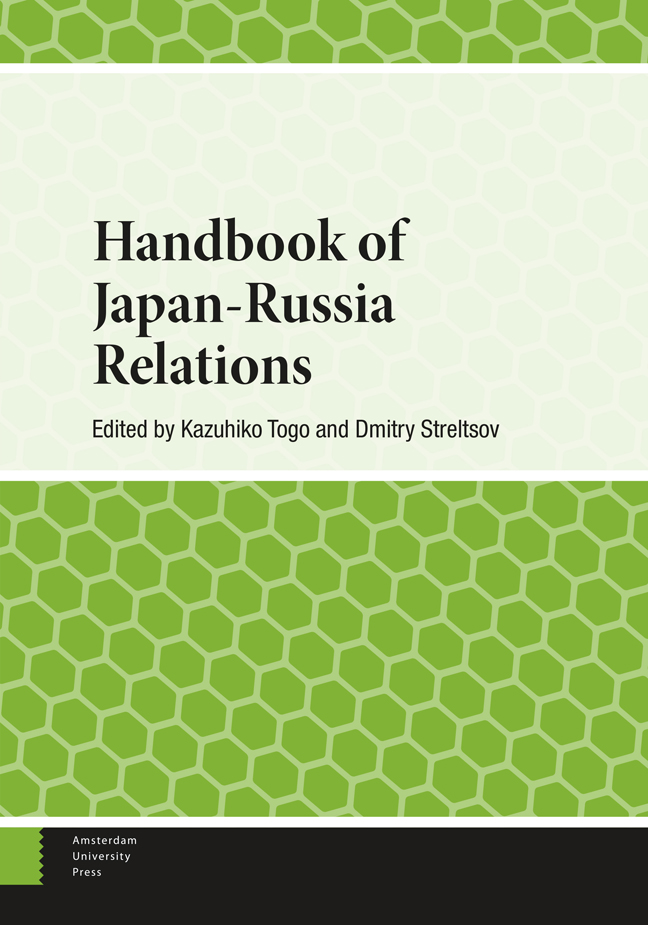Book contents
- Frontmatter
- Contents
- Dedication
- Acknowledgements
- Contributors
- Abbreviations
- Introduction
- Part 1 War and Peace: Diplomatic Relations and Security
- Part 2 Territory
- Part 3 The Economy and Energy
- Part 4 Disaster Cooperation
- Part 5 Culture
- Part 6 Perceptions of the Other
- Appendix 1 1956 Joint Declaration
- Appendix 2 Tokyo Declaration (1993)
- Appendix 3 Moscow Declaration (1998)
- Appendix 4 Irkutsk Statement (2001)
- Appendix 5 Foreign Ministry Statement (2022)
- Index
2 - Japan-Russia Diplomatic Relations from the Russo-Japanese War to the Treaty of San Francisco
Published online by Cambridge University Press: 26 March 2024
- Frontmatter
- Contents
- Dedication
- Acknowledgements
- Contributors
- Abbreviations
- Introduction
- Part 1 War and Peace: Diplomatic Relations and Security
- Part 2 Territory
- Part 3 The Economy and Energy
- Part 4 Disaster Cooperation
- Part 5 Culture
- Part 6 Perceptions of the Other
- Appendix 1 1956 Joint Declaration
- Appendix 2 Tokyo Declaration (1993)
- Appendix 3 Moscow Declaration (1998)
- Appendix 4 Irkutsk Statement (2001)
- Appendix 5 Foreign Ministry Statement (2022)
- Index
Summary
After Japan’s decisive victory in the Russo-Japanese War of 1904–1905, the strategic paradigm in North East Asia dramatically changed. Japan and Russia began cooperating to expand their respective spheres of influence, and the US became an unwelcome third country. That took shape in four Russo-Japanese agreements, but the 1917 Revolution changed that paradigm. The Soviet Union and Japan had difficult negotiations settling Japan’s Siberian intervention but finally succeeded by concluding the Basic Rules Convention in 1925. This eventually led the two countries to conclude the Neutrality Pact in April 1941. However, in the concluding period of World War II, the Soviet Union made a last-minute attack on August 9, 1945. The San Francisco peace treaty conference was held in September 1951 but the Soviet Union did not sign the treaty. The postwar settlement had to wait until the 1956 Joint Declaration where all but the territorial issue, covered in Clause 9, was resolved.
Introduction
The first contact between Japan and Russia dates back to the time of Peter the Great who, in 1701, gave an audience to Denbei who had drifted in to Siberia from Japan. In 1791 a brave Osaka merchant, Daikokuya Kodayu, helped greatly by Professor Kirill Laksman, was given audience by Empress Catherine. Then in 1811, Hakodate merchant Takadaya Kahei and Russian naval officer Vasily Golovnin and his colleague Petr Ricord helped each other to quell a collision between the two sides. Relations up to this time were based on a local and personal level.
Eventually these led Admiral Yevfimiy Putyatin to conclude in 1855 the Treaty of Commerce and Navigation (Treaty of Shimoda), the first treaty which demarcated the border between the two countries. It was followed in 1875 by the Treaty of Exchange of Sakhalin for the Kurile Islands.
However, as Russia was one of the leading European military powers and Japan rapidly followed the path of Euro-American military powers, war exploded in 1904 between Japan and Russia to determine the respective sphere of influence in Korea and Manchuria. This war ended with a decisive Japanese victory and was concluded in 1905 by the Treaty of Portsmouth. The real art of crafting diplomatic relations between Japan and Russia started from the end of Russo-Japanese War.
- Type
- Chapter
- Information
- Handbook of Japan-Russia Relations , pp. 19 - 30Publisher: Amsterdam University PressPrint publication year: 2024

